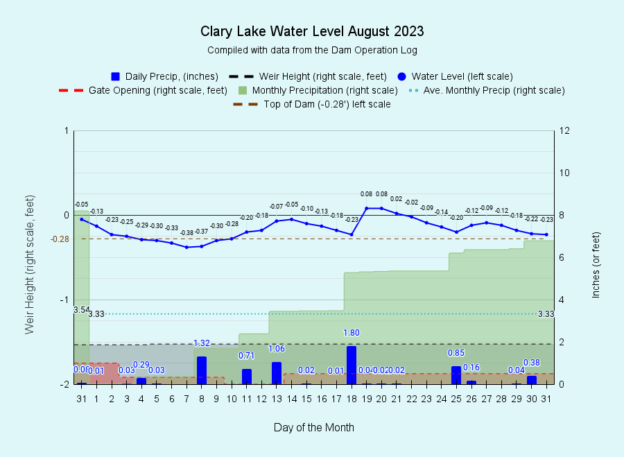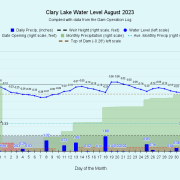I have archived the August 2023 water level chart (above, and at left). The rain we’ve come to expect this summer did not disappoint! We received a total of 6.79 inches in a month when normal is more like 3.33 inches. For the month of August we’re at 204% of normal; we recorded some amount of rain on 18 of the 31 days of the month. All this rain puts us at 41.44 inches for the year, fully 13.69 inches more than normal for this date. We normally receive around 44 inches of rain in a whole year. Quite impressive! Not surprisingly, the lake level bebopped along merrily in a narrow range between the top of the dam and the High Water Mark. The average water level for the month was -0.17 feet below the HWM; it briefly dropped below the top of the dam for 5 days and rose above the HWM for a couple. For most of the month we kept the gate open half a foot to keep the lake from rising too high. We’ve never had that concern in August!
Our lake water quality has remained pretty good all summer (see transparency chart at left) though we’ve been flirting with increased algae growth off and on since the first of June. What has saved us is all the rainfall which has diluted the lake water and as a result, all the water that has been leaving the lake and taking with it phosphorus and other nutrients that feed algae. The net effect of all this rain has been to keep nutrient levels and the algae population low. Compare this with last year when we had almost no outflows from May until October and over a foot of water lost primarily due to evaporation. Those conditions were the exact opposite of this summer and led to 3 months (September through November) of the worst algae bloom anyone can remember. All this “flushing” has also kept the conductivity of our lake water low. Conductivity is generally viewed as a proxy for lake productivity: the more dissolved solids there are in the water the higher the conductivity, and the greater the likelihood of seeing algae population growth. This is the first year we’ve been recording lake water conductivity. You’ll be hearing more about it in coming months.
Lest we become complacent, remember: we’re not out of the woods yet! The algae bloom “season” is just ahead. Early this coming fall, wind and cooling air temperatures will cause the lake to “turn over” and all the colder oxygen deficient but Phosphorus rich water at the bottom will mix with the upper warmer, sunlit layer where the algae live. This is often the shot in the arm blue-green algae needs to spur exponential population growth resulting in an algae bloom. On our last water quality monitoring session back on August 19th, the lake water was just beginning to show the signs of mixing and by now it’s likely well underway. We’ll continue to monitor lake water quality and Phosphorus levels through the middle of October and will keep you posted.
We hope to see you at the CLA Annual Meeting this coming Saturday, and don’t forget to grab some raffle tickets!



